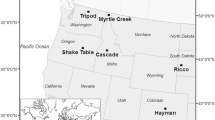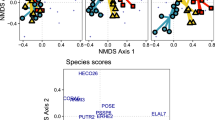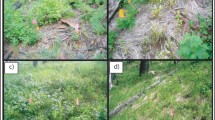Abstract
In recent years, the use of postfire mulch treatments to stabilize slopes and reduce soil erosion in shrubland ecosystems has increased; however, the potential effects on plant recovery have not been examined. To evaluate the effects of mulching treatments on postfire plant recovery in southern California coastal sage scrub, we conducted a field experiment with three experimental treatments, consisting of two hydromulch products and an erosion control blanket, plus a control treatment. The area burned in 2007, and treatments were applied to six plot blocks before the 2008 growing season. Treatment effects on plant community recovery were analyzed with a mixed effects ANOVA analysis using a univariate repeated measures approach. Absolute plant cover increased from 13 to 90% by the end of the second growing season, and the mean relative cover of exotic species was 32%. The two hydromulch treatments had no effect on any plant community recovery response variable measured. For the erosion control blanket treatment, the amount of bare ground cover at the end of the second growing season was significantly lower (P = 0.01), and greater shrub height was observed (P < 0.01). We conclude that postfire mulch treatments did not provide either a major benefit or negative impact to coastal sage scrub recovery on the study area.

Similar content being viewed by others
References
Allen EB, Cox RD, Tennant T, Kee SN, Deutschman DH (2005) Landscape restoration in southern California forblands: response of abandoned farmland to invasive annual grass control. Israel Journal of Plant Sciences 53:237–245
Benik SR, Wilson BN, Biesboer DD, Hansen B, Stenlund D (2003) Evaluation of erosion control products using natural rainfall events. Journal of Soil and Water Conservation 58(2):98–105
Beyers JL (2004) Postfire seeding for erosion control: effectiveness and impacts on native plant communities. Conservation Biology 18:947–956
Beyers JL, Wakeman CD, Wohlgemuth PM, Conard, SG (1998) Effects of postfire grass seeding on native vegetation in southern California chaparral. In: Proceedings of the 19th annual forest vegetation management conference, 20–22 January, 1998, Redding, CA
Cal Fire (2007) Witch fire incident information. California Department of Forestry and Fire Protection. http://cdfdata.fire.ca.gov/incidents/incidents_details_info?incident_id=225. Accessed online 11 February, 2011
California Climate Data Archive, Western Regional Climate Center (2011) http://wrcc.dri.edu/cgi-bin/cliMAIN.pl?ca7874. Accessed 28 September 2011
Cione NK, Padgett PE, Allen EB (2002) Restoration of a native shrubland impacted by exotic grasses, frequent fire, and nitrogen deposition in southern California. Restoration Ecology 10:376–384
Cox RD, Allen EB (2008) Stability of exotic annual grasses following restoration efforts in southern California coastal sage scrub. Journal of Applied Ecology 45:495–504
Faucette LB, Risse LM, Jordan CF, Cabrera ML, Coleman DC, West LT (2006) Vegetation and soil quality effects from hydroseed and compost blankets used for erosion control in construction activities. Journal of Soil and Water Conservation 61(6):355–362
Gillespie IG, Allen EB (2004) Fire and competition in a southern California grassland: impacts on the rare forb Erodium macrophyllum. Journal of Applied Ecology 41:643–652
Gillespie IG, Allen EB (2008) Restoring the rare forb Erodium macrophyllum to exotic grassland in southern California. Endangered Species Research 5:65–72
Godfrey SH, Curry MK (1995) TTI hydraulics and erosion control laboratory research field performance of erosion-control blankets. Landscape and Urban Planning 32:161–167
Grismer ME, Schnurrenberger C, Arst R, Hogan MP (2009) Integrated monitoring and assessment of soil restoration treatments in the Lake Tahoe Basin. Environmental Monitoring and Assessment 150:365–383
Herrick JE, Van Zee JW, Havstad KM, Burkett LM, Whitford WG (2005) Monitoring manual for grassland, shrubland, and savanna ecosystems. US Department of Agriculture–Agricultural Research Service (USDA-ARS) Jornada Experimental Range, Las Cruces, NM
Lightner J (2006) San Diego County native plants. San Diego Flora, San Diego
Montalvo AM, McMillan PA, Allen EB (2002) The relative importance of seeding method, soil ripping, and soil variables on seeding success. Restoration Ecology 10:52–67
Mooney HA (1977) Southern coastal scrub. In: Barbour MG, Major J (eds) Terrestrial vegetation of California. Wiley Interscience, New York, pp 471–479
Profile Products (2008a) Cellulose fiber specifications. Conwed Fibers, Buffalo Grove, IL
Profile Products (2008b) Hydro-blanket BFM specifications. Conwed Fibers, Buffalo Grove, IL
Robichaud PR, Beyers JL, Neary DG (2000) Evaluating the effectiveness of postfire rehabilitation treatments. General Technical Report RMRS-GTR-63. U.S. Department of Agriculture, Forest Service, Rocky Mountain Research Station: Fort Collins. pp 85
Robichaud PR, Brown RE (2005) Postfire rehabilitation treatments: are we learning what works? In: Moglen GE (ed) Managing watersheds for human and natural impacts: engineering, ecological, and economic challenges. Proceedings of the 2005 watershed management conference, 19–22 July 2005. American Society of Civil Engineers, Alexandria, VA, pp 1–12
Rundel PW (2007) Sage scrub. In: Barbour MG, Keeler-Wolf T, Schoenherr AA (eds) Terrestrial vegetation of California. University of California Press, Berkeley, pp 208–228
SAS (2009) JMP 8.0.1. SAS Institute Inc, Cary
Wohlgemuth PM, Robichaud P, Hubbert KR, Beyers JL (2006) Evaluating the effectiveness of mulching as a postfire erosion control treatment. In: Third international fire ecology and management congress, San Diego Fire Recovery Network, San Diego, CA
Wolkovich EM, Bolger DT, Cottingham KL (2009) Invasive grass litter facilitates native shrubs through abiotic effects. Journal of Vegetation Science 20:1121–1132
Zink TA, Allen MF (1998) The effects of organic amendments on the restoration of a disturbed coastal sage scrub habitat. Restoration Ecology 6:52–58
Acknowledgments
We thank Shea O’Keefe at the NRCS Escondido Field Office for support. Alexandra Campbell, Christa Horn, Matt Kedziora, and Katie Merrill all assisted with field data collection. Dr. Lisa Nordstrom and Dr. Douglas Deutschman provided guidance during data analysis. Dr. Edith Allen and two anonymous reviewers read previous versions of this manuscript, which enabled us to make significant improvements. We also thank HydroSprout, Inc. for hydromulch application and the Sefton Summer Fellowship for position support. This project was funded by the USDA Natural Resources Conservation Service and the San Diego Zoo Global.
Author information
Authors and Affiliations
Corresponding author
Rights and permissions
About this article
Cite this article
McCullough, S.A., Endress, B.A. Do Postfire Mulching Treatments Affect Plant Community Recovery in California Coastal Sage Scrub Lands?. Environmental Management 49, 142–150 (2012). https://doi.org/10.1007/s00267-011-9777-2
Received:
Accepted:
Published:
Issue Date:
DOI: https://doi.org/10.1007/s00267-011-9777-2




